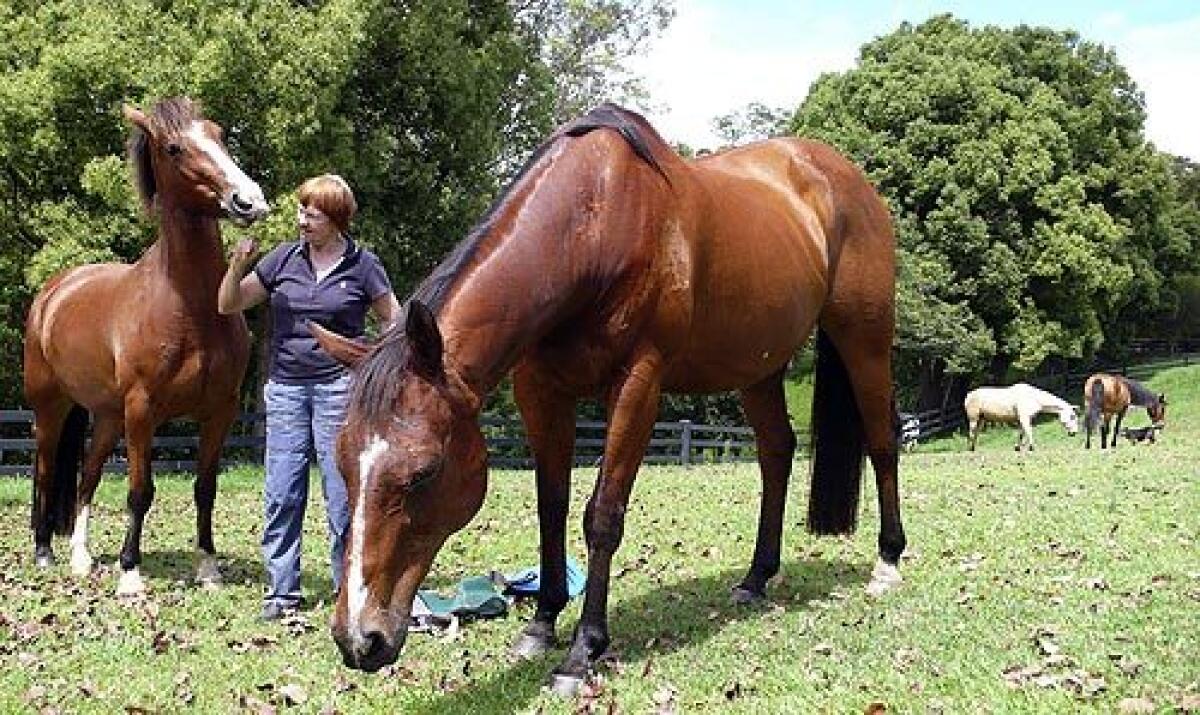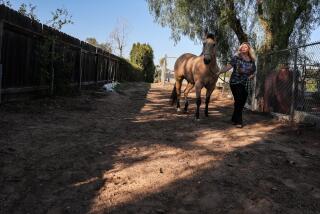Plight of the brumbies

- Share via
BELLINGEN, AUSTRALIA — Adam watched as his mother and father were gunned down.
Rosie was just 4 weeks old when her mother died after being caught in a trap. She almost didn’t make it.
Pixie lost her newborn,who suffered a broken leg, and even after she became pregnant again, was still deeply depressed.
If horses could talk, these are a few of the stories they might share now that they live at this small sanctuary on Australia’s east coast, home to some of the most bruised and battered wild creatures from the land down under.
Here, the horses roam free, far from the trauma that still awaits many of their kind. That’s because Jan Carter, a harpist turned horse rescuer, has devoted her family farm and life savings to helping them.
“This nation is built on the back of horses,” says Carter, 67, a petite grandmother with short red hair and deeply tanned skin who drives an old pickup smelling of the hay and earth that covers the soles of her boots. “They should be preserved and protected.”
Australia is home to an estimated 300,000 wild horses, the largest such population in the world. This abundance is believed to have put so much strain on the habitat that the Australian government has resorted to controversial mass culling campaigns to protect the country’s national parks.
Images of hunters chasing herds of galloping horses from helicopters and shooting them with semiautomatic rifles have sent shock waves across Australia, where horses are proud symbols of the country’s pioneer spirit. The killing first came to public attention in 2000, when 600 horses were killed in the Guy Fawkes River National Park in New South Wales, about an hour-and-a-half drive from here.
Public outcry forced the government to halt the helicopter shooting in this part of the country, but it could not stop aerial and ground assaults, often carried out in secret, in other parts of the vast Australian outback. More than 10,000 horses are expected to be shot in Queensland in the next three years, according to an investigation by a newspaper in the state.
Animal rights activists are looking for a gentler solution to horse overpopulation, but that pits them against an unlikely foe -- environmentalists who want to stop the Australian version of the mustang from further trampling pristine land.
“Horses are exotic animals that don’t belong in Australia,” says Keith Muir, director of Colong Foundation for Wilderness, a Sydney-based nonprofit environmental group that supports the culling of wild horses. “If kangaroos got loose in America, they would be like the horses here. You’ll be shooting them like mad to try and control them.”
Also known as brumbies, possibly after an early English settler, the animals are descended from horses that were shipped from England to Australia in the late 1700s. Those sturdy beasts survived the harsh journey and extreme frontier conditions and, in the process, advocates say, built up superior genes that could prove invaluable if the brumbies were bred with domesticated horses.
The plight of the wild horses is a reflection of the changing Australian outback as much as a result of a recent record drought.
Small-time farmers and ranchers who once made up the bulk of the Australian economy are being pushed out of existence by giant agribusinesses. When the mom-and-pop outfits put their properties on the market, the lots are usually too small to interest bidders other than the national parks.
Critics say the government keeps buying land populated by large numbers of horses, but it doesn’t have the money to support long-term management.
Horse advocates want a federal policy that bans shooting everywhere and manages overpopulation through infertility drugs and adoption programs. Some have even proposed using the horses as tourist attractions, much like the Dartmoor ponies of southwest England.
“But to get the Australian government to that stage is very difficult,” Carter says. “They do not address the problem. What they do is wait for the population to build up, shoot them from the air or ground, wait a few years and do it again.”
In New South Wales, where the aerial shooting has been replaced by a trapping program, the animals are turned over to people such as Carter to prepare for adoption.
In the last two years, “Save the Brumbies,” her nonprofit group staffed by four full-time volunteers, has taken in more than 250 horses. But that’s a tiny portion of the number of animals rounded up with nowhere to go but the abattoir.
“About 98% of the captured horses are sent to the slaughterhouse. It’s dreadful,” says Carter, whose sanctuary can take in only about 50 animals at a time because of a lack of funding and space.
Before a wild horse is ready for adoption, it must go through a two-month program, during which it is wormed, gelded, and handled to help familiarize it with humans.
The process costs about $700 per horse, and everything is paid for by donations and adoption fees, which range from $300 to $900, depending on the quality of the animal.
The best-adjusted are the first to find new homes. The weakest and wildest stay in Carter’s sanctuary for more personal attention, and sponsors send money to support those horses.
Carter’s strong affinity for the horses is rooted partly in her own struggles to survive back-to-back family tragedies.
She lost her husband 24 years ago, when he died unexpectedly from a blood clot in his brain. He was 44. She tried to move on by selling the family home in Sydney and buying a farm, where she planned to live with her older son, Scott, a telephone repairman and pianist who shared his mother’s passion for music and her love of nature. But just as they were starting the venture, Scott, 28, died in a head-on collision.
“We were going to run it as a bed-and-breakfast,” Carter says. “I had moved here one week. Scott had to work and finish his contract. He was supposed to come up the following week. But he never made it.”
With her younger son busy with his life as an executive in the city, Carter was alone in her new rural retreat with no idea how to run it. But that turned out to be just what she needed.
“I couldn’t just sit back and feel sorry for myself,” she says. “I had to get up and learn how to manage cattle, how to do weed control, learn about pasture and soil and all that sort of thing.”
Then came the brumbies, who helped her conquer her grief and find new purpose in life. The horses are like children to her, and their stories of remarkable recovery are a testament to her lifelong affection for the animals.
Born in London during World War II, Carter fell in love with horses when she was 4. She remembers seeing her first horse, which belonged to the baker who delivered bread by cart. He allowed the little girl to feed the animal crumbs from his basket.
She got her first pony two years after the family moved to Australia when she was 8. She didn’t stop riding until her two sons were born.
After a 15-year break, she picked up the saddle again. The first horse she bought and rode was Guy, now a 26-year-old who is completely devoted to her.
They used to ride through the Guy Fawkes River National Park and watch the glory of wild horses nearby. She was appalled to learn that these animals were being shot from above, but she didn’t know how to help.
Then she turned to her harp. The music dashed out from her fingertips and she recorded an entire CD devoted to the plight of the brumbies called “Run With the Wind.”
She sold the CDs at concerts and on the Internet, talked to everybody she could about these horses, and donated all the money to saving them. “If it wasn’t for the CD, there wouldn’t be a charity,” she says.
This past year, she and two other volunteers jointly purchased 1,400 acres of bush land to set up a second sanctuary. Carter’s share of the $400,000 came out of her retirement money, and she wrote a will that makes sure the land will be used in perpetuity as a sanctuary.
“This is Jock,” she says, pointing to a chestnut horse grazing peacefully on picture- perfect green pastures. “He was so thin when he came in, it was scary. He was also very, very wild and spooky. They said he was too poor to be handled. Now look at him.”
As she speaks, Guy nudges against her arm, trying to get her attention.
“He’s jealous,” she says. “I’ve had him a long time. If he sees me feeding the brumbies, he likes to stick his nose in and say, uh, what are you doing?”
Carter says she can remember every one of the more than 250 horses she’s rescued. She named most of them herself.
“We like army names for the boys, like Sergeant and Major,” she says. “For girls, we like Wattle and Willow. At the moment we are on a music theme, like Aria and Symphony.”
She hates it when her beloved horses are described as feral pests causing environmental degradation.
“Cattle are also not indigenous to Australia, feral pigs are not indigenous to Australia. They also cause incredible damage to the environment, as do wild cats and dogs,” Carter says. “But environmentalists pick on horses because they are big and easily seen. . . . Cattle -- they can’t shoot them because they are owned by someone. Horses are not.”
Environmentalists such as Muir, however, see what Carter is doing as a well-meaning effort that doesn’t reduce the horse population fast enough to protect the environment. Although aerial shooting is not ideal, he says, it is effective.
“Humane treatment of animals is important,” Muir says. “But when you are dealing with the last remaining wild land, and animals that don’t belong here, you have to make a choice between the lesser of two evils. Sometimes that means controlling the feral animals by methods that work.”
But Carter says shooting doesn’t always kill the animals right away and they are left to suffer. Or they leave behind babies who starve without their mothers.
Like the traumatized Adam, a buckskin she rescued from the 2000 aerial cull.
“Somehow he missed the bullet,” Carter says. Then she shows off some of his tricks.
“Adam, how do you do?” she says, putting her hand out to shake his outstretched hoof.
“Adam, give me a kiss,” she says. Without hesitation, he reaches down to nose her on the cheek.
More to Read
Sign up for Essential California
The most important California stories and recommendations in your inbox every morning.
You may occasionally receive promotional content from the Los Angeles Times.










